If you’ve ever wondered what it is like to hunt as early peoples did, then hunting with a bow is definitely going to be worth your time and energy.
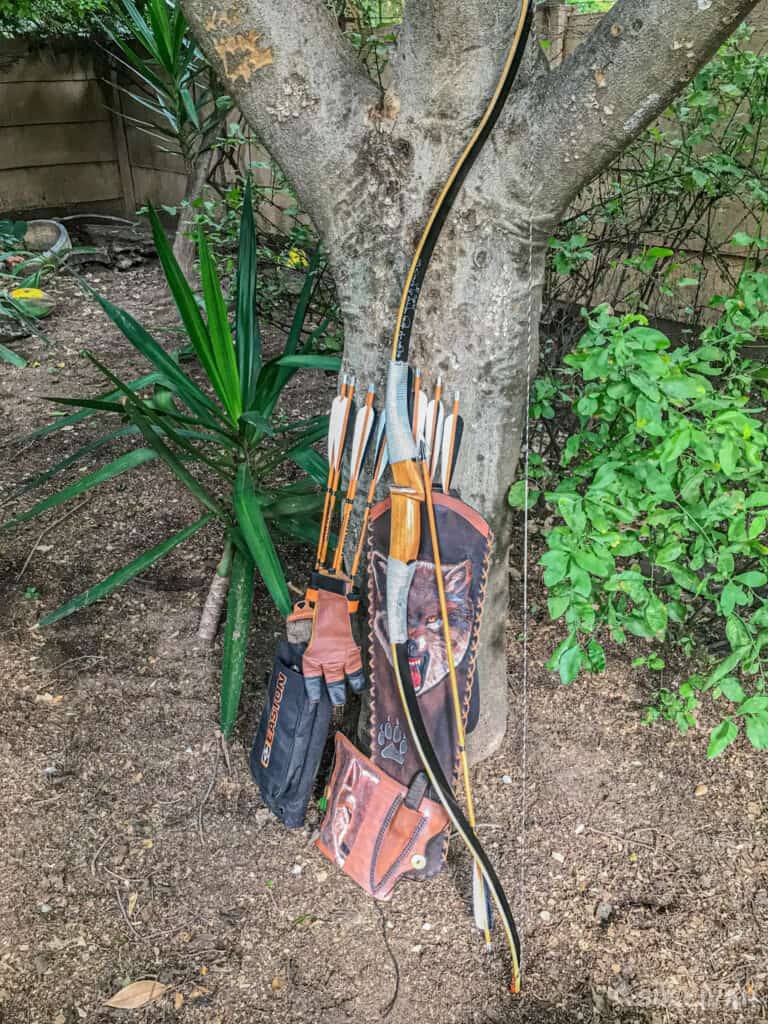
As an avid hunter and woodsman since my childhood, my brothers and I were out from early morning to evening ranging far and wide, hunting and fishing. Our first hunting endeavors would cover sticks and stones, slings, and homemade bows.
Today the array of equipment available is mind-boggling, and so varied that, as a beginner, it is almost too daunting a task to undertake.
I will make your task a little easier, breaking down the essentials of bow hunting to get you out in the field and enjoying the thrill of the hunt, one that challenges you as you meet your quarry on an equal footing.
Your equipment will be only one part of the hunt, your mental and physical condition, and skill will be tested, and each step on your journey will be a lesson in itself.
Table of Contents
A Short History of Bows
The bow was born when a piece of the branch was strung with a piece of leather, sinew, or fiber rope, and a flint-tipped stick was shot from it.
The earliest bow remains were discovered in Denmark and dated to 9000BC. The earliest use of bows in America is around 500 BC by Native American tribes.
Bows were made from tough woods or bone and generally followed the “C” shape we are familiar with from our childhoods.
Through the ages, the bow has undergone varied and significant changes, with the Mongol Recurve bow being considered one of the best examples and the forerunner of the modern recurve bow.
These bows had an incredible range of +/-450 yards (+/-500 meters), especially for the time.
A bow was a coming-of-age gift for most Mongol children, men and women. Considering the Mongol bow took a year to construct, it was a bow build of passion and necessity, it provided food and protection.
The compound bow has made the evolutionary jump from the earliest bow configurations through the recurve bows evolution to take the lead in bow design and power to weight ratios.
The ease of use and ability to fire arrows at much-increased speeds while holding less poundage at the draw has set these bows apart and into a new league.
Bows Can Be Powerful
A recurve bow of 30-pound draw weight literally means that when you pull the bow string back to its maximum point or hold, you will be holding the string back with 30 pounds of pressure on the string.
When you release the bow string, the arrow will be pushed forward and released with 30 pounds of pressure.
Consider that a medieval English Longbow would require 80 to 150 pounds of pressure to pull the bow string to maximum.
The average man’s grip strength is around 75 pounds while a women’s average around 45pounds of grip strength pressure.
Compound bows work similarly to a block and tackle system, using the mechanical advantage to move more weight than you would normally be able to.
What this means is that when you pull on the 30-pound bow string the cam or wheel system will via its camber system reduce the amount of poundage you will hold at the end of the maximum draw.
This poundage will be reduced by half or more depending on the type of system being used.
Getting Started
Choices, choices, that’s what you are faced with not just from an equipment perspective but also regarding quarry, traditional bows or modern bows using wheels and cams, environments, and applications.
From instinctive point shooting to sophisticated sighting systems, these factors will all influence the experience you will have in the world of archery and bow hunting.
As a new archer, I recommend that you start with a basic system that can be weight-adjusted as your physical conditioning and skill level improves.
Bow Types
Modern technology and access to advanced bow making techniques and resources has revolutionized the bow in comparison to its ancestral linage. Yet the new debate rages between traditional bow hunting and the modern archer.
Purists will argue for the traditional bow and the modern bow will have their supporters. So how do you choose yours?
Recurve Bows
The bow itself is relatively unchanged in concept, modern materials have made the bow stronger, lighter and more powerful.
Recurve bows are cheaper and a great starter bow for those interested in archery. Most archery ranges will let you hire a bow before you spend your hard-earned cash.
The small curves at the point of the bow’s limbs will curl back when the bow is drawn, increasing the force that is applied to the bow string, and adding velocity to the arrow.
In essence, this innovation has led the way to the compound bow’s development.
The lighter poundage bows run around 25 to 30 pounds of the draw which is a comfortable starting weight, and they go up in weight to around the 55 to70 pound mark. Bows in this heavier range need more strength to not only draw but hold.
The recurve bow comes in a fixed weight like my solid 60-pound horse bow or in a take-down version which will allow the user to swap out the detachable limbs, thus increasing the poundage.
This is useful for changing up the weight as you get stronger and more experienced.
Recurve bows are of a fixed draw length depending on the draw length that your retailer will fit for you, or you can work it out for yourself using a simple measurement.
Distance between your outstretched arms divided by 2.5 will give you an approximate raw length.
Recurve bows are suitable for target range shooting, field and 3D target shooting and hunting, they are light but longer and can be more difficult to handle in the field.
The lower power and speed of the arrow’s flight mean shorter rangers from the target and if hunting you’ll require more skill in the field, better shot placement and knowledge of your intended target.
The basic shape of a bow hasn’t changed shape in thousands of years, what has changed is the technology that has poured into the development of a more effective piece of equipment, more efficient, accurate and less demanding on the archer.
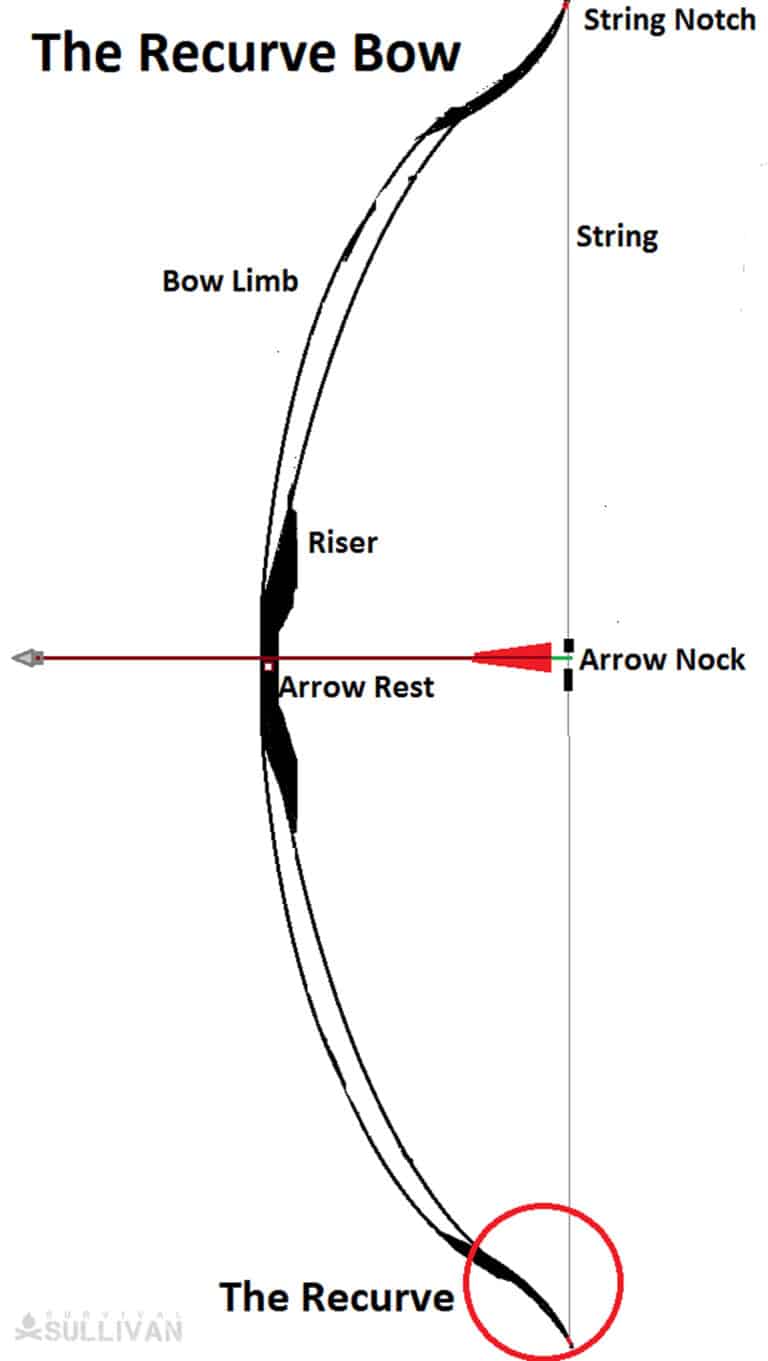
Looking at the basic construction of a bow it can be broken down into:
- The Riser, which is the handle of the bow
- The limbs, are the two pieces that flow out of the riser to which the bow string is attached
- The Bow String
- The arrow rest or seat is nestled in the riser into which the arrow will rest
- The Recurve
- The String Notch
Compound Bows
Compound bows heralded the next evolutionary step in the bow’s development.
Using a wheel or Cam attached to the end of the bow’s limbs and a pulley system between the two points, the archer can draw more than would normally be possible with a recurve bow.
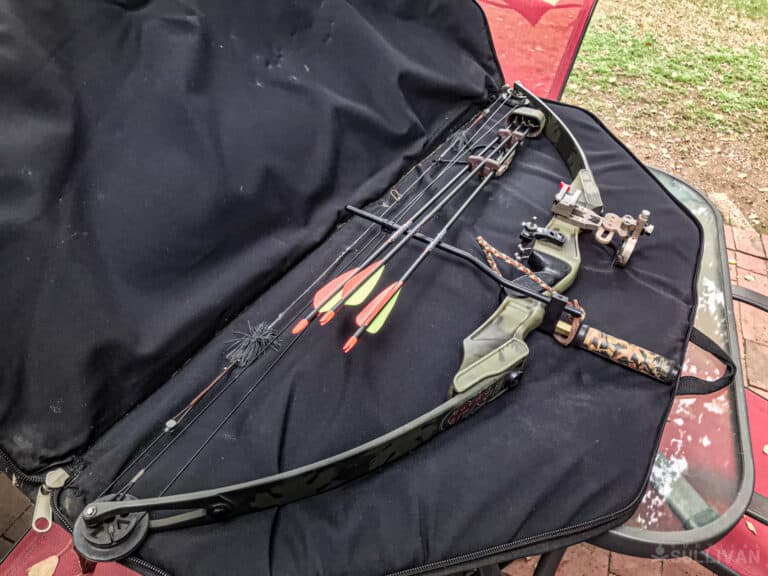
Most compound bows’ draw weights are adjustable with adjustable cams. These bows are heavier than their recurve counterparts, with more moving parts.
They are able to be shorter than a recurve and more versatile in the field, being able to generate more power for less energy expended by the archer. Bows of 40 pounds are able to take medium-sized to larger game with reliability.
The compound bow can be used for indoor target shooting field and 3D shooing and hunting. Most bow hunters prefer the compound bow for its power and flatter shooting accuracy.
Even though targets can be taken reliably at longer ranges, field craft is still an essential skill.
Compound bows can a so be accessorized to a far greater degree than a recurve bow, with sight systems, counter weights, arrow rests and bow quivers.
The price of compound bows starts at around $300 dollars for a basic system and goes up.
Maintenance needs to be more regular, about once a year and generally can only be handled by a retailer, however once tuned your bow will remain on point for a fair while depending on how much you use it.
The Compound Bow retains the basic shape of its ancestry while incorporating advanced physics and technology:
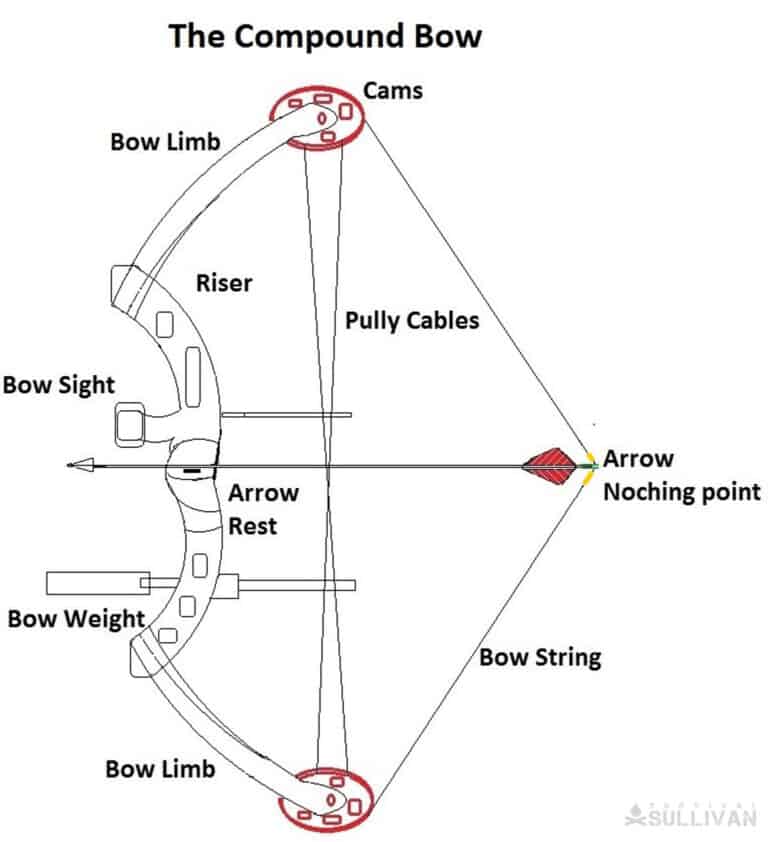
- Cams and Pully Cables – assist in the breakdown of the draw weight that the archer will hold.
- The bow string
- Bow Sight
- Riser – Handle
- Bow Weight – Providing a counter balance
- Arrow rest
- Bow Limbs
- Arrow Nocking Points
The Arrow
The arrow is a very precise piece of equipment and requires a little explanation. “Have bow will shoot,” is not that simple as arrow weight and bow poundage have an impact on how the arrow will perform.
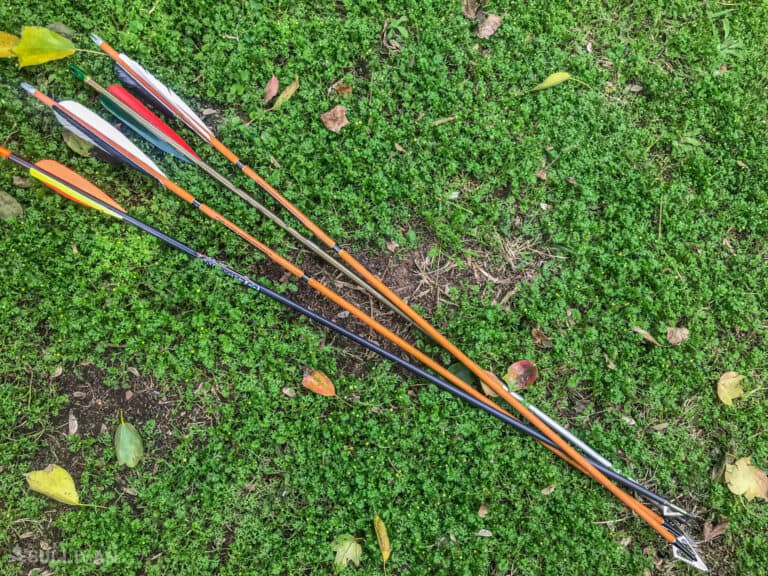
The simple version is the heaver your bow poundage the heaver your arrow needs to be, this is because an arrow “snakes” through the air when it leaves your bow.
The stiffness of an arrow is called the spine and in general, your retailer will advise you on the correct arrows for your needs.
This goes for arrow length, too short is dangerous as you can put an arrow through your hand, too long and the arrow will be out of balance. About an inch to 2 inches of arrow past the riser will be a good option.

Bear in mind that the spine will weaken over time with use and must be changed once they begin to lose its accuracy.
Arrows can be complicated and are made from wood, carbon fiber, aluminum, and composite carbon fiber/aluminum.
Different arrows for different applications such as target shooting, field archery and, in our case, hunting.
The arrow has feathers or plastic vanes attached to help balance and stabilize its flight. These are called the fletching.
You will see that two are the same color, and one is not; this is so that the two facing in the form a flat side to allow the arrow to pass the riser smoothly:
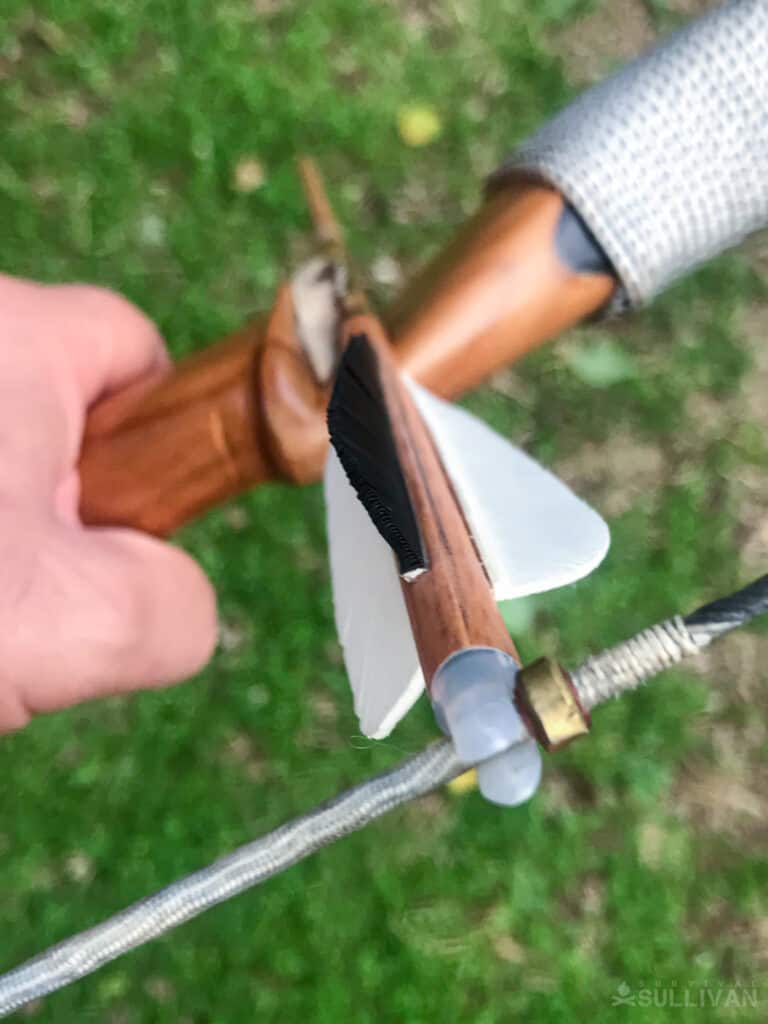
I personally use Easton arrows who have a useful guide on their website to arrow selection.
Arrowheads
As arrow weight and bow poundage affect the flight of the arrow, so does the tip that you use. Most modern arrows come with an insert allowing for interchangeable tips.
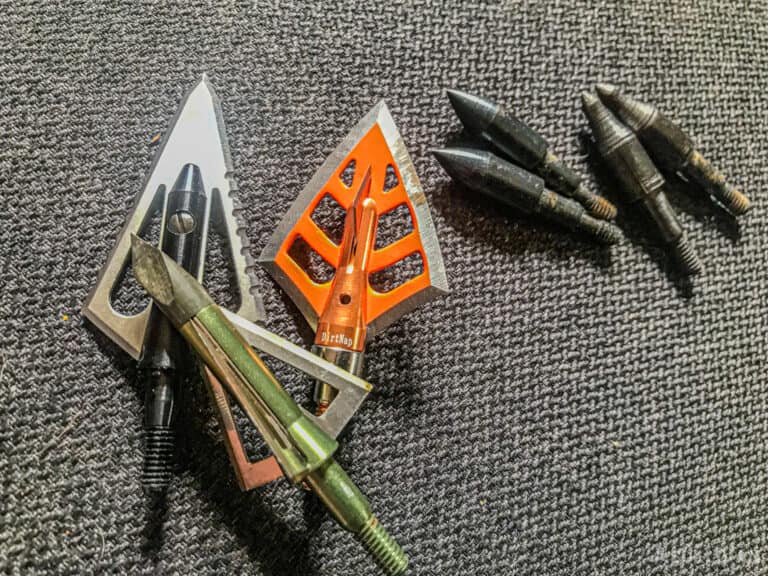
The rule of thumb is don’t use an arrow tip that is too heavy for the shaft; the arrow will not fly true and can be dangerous. Consult your retailer or the Easton arrow and tip guide.
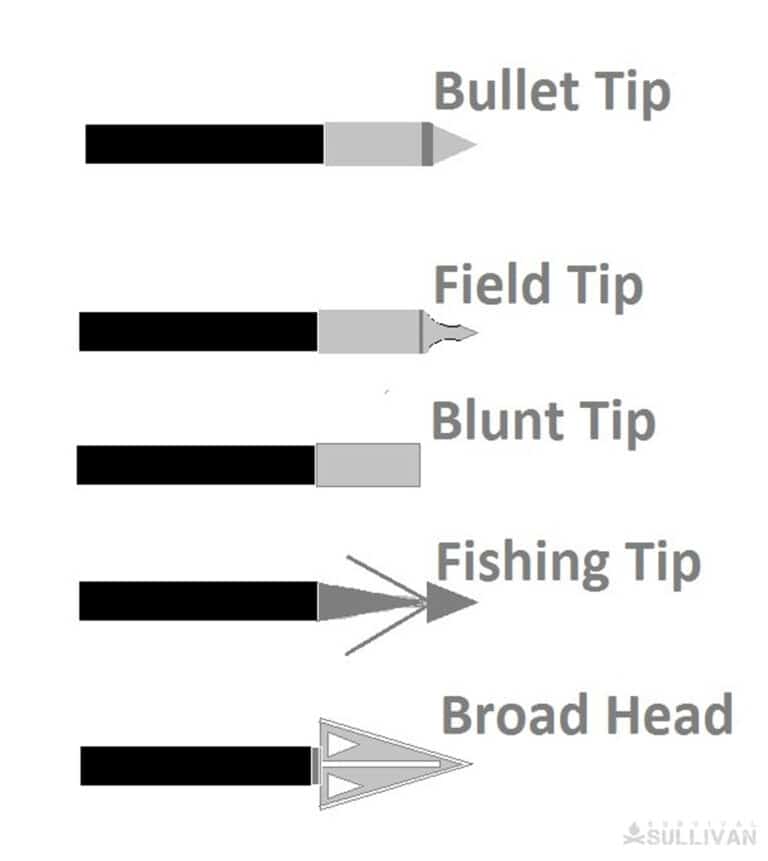
- Bullet tips are useful for indoor target shooting, soft target shooting and small game hunting.
- Field tips are good for field target shooting and small game.
- Blunt tips are good for birds and small game.
- Fishing tips have barbs that retain the fish once its shot and a line attached is used to pull in the fish.
- Broad heads are used for medium to big game, they vary in weight, size and blade conformation. These arrow tips are usually razor-sharp to ensure as clean kill.
Accessories
Disclosure: This post has links to 3rd party websites, so I may get a commission if you buy through those links. Survival Sullivan is a participant in the Amazon Services LLC Associates Program. As an Amazon Associate, I earn from qualifying purchases. See my full disclosure for more.
The accessory market is huge, with a multitude of manufacturers. An essential for any form of archery is an arm guard to protect the bow hand’s arm from string impact, which will leave a mighty bruise and burn like fire.
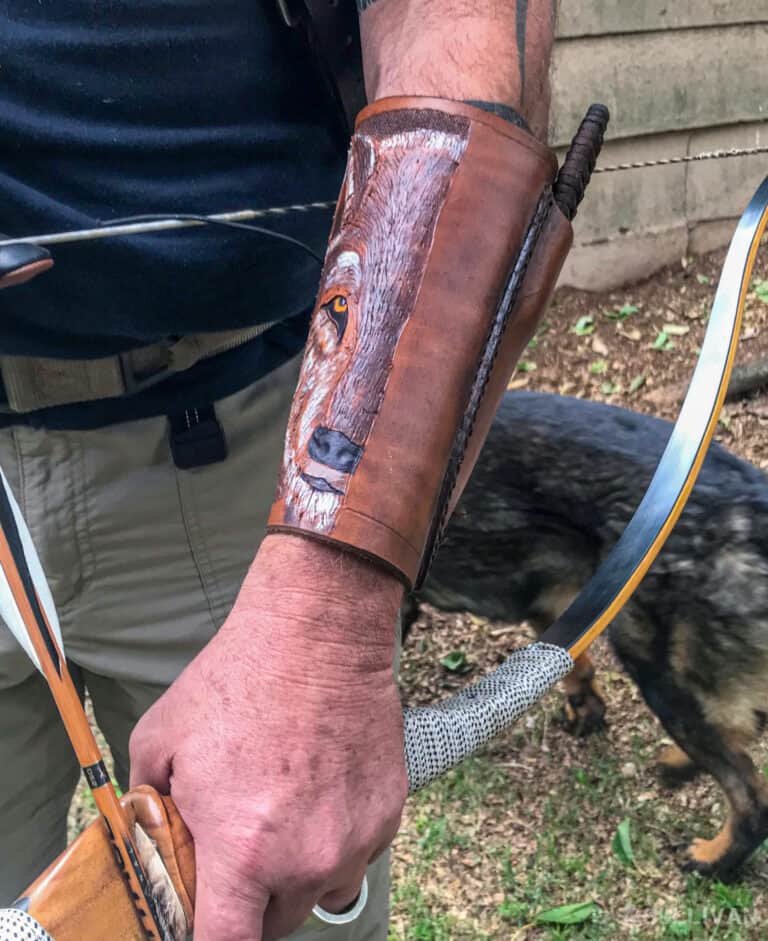
I have custom-made leather arm guards and fitted a knife to my left forearm guard, you can have them made or make them yourself if you are of a mind.
These arm guards can be customized at will, just remember function over form, it must fulfill its primary function to protect the arm and not foul the bow string.
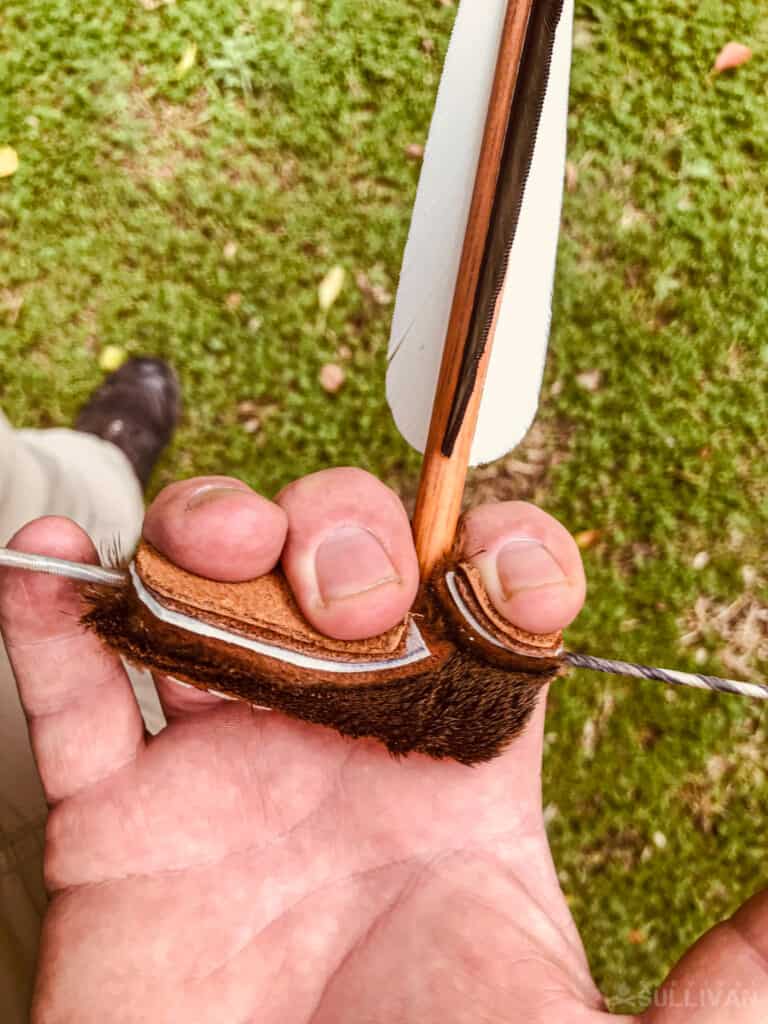
Tabs and bow gloves protect the fingertips of the draw hand, and the string pressure, and release can cause blisters and the loss of feeling resulting in an uneven release of the arrow leading to inconsistent accuracy.
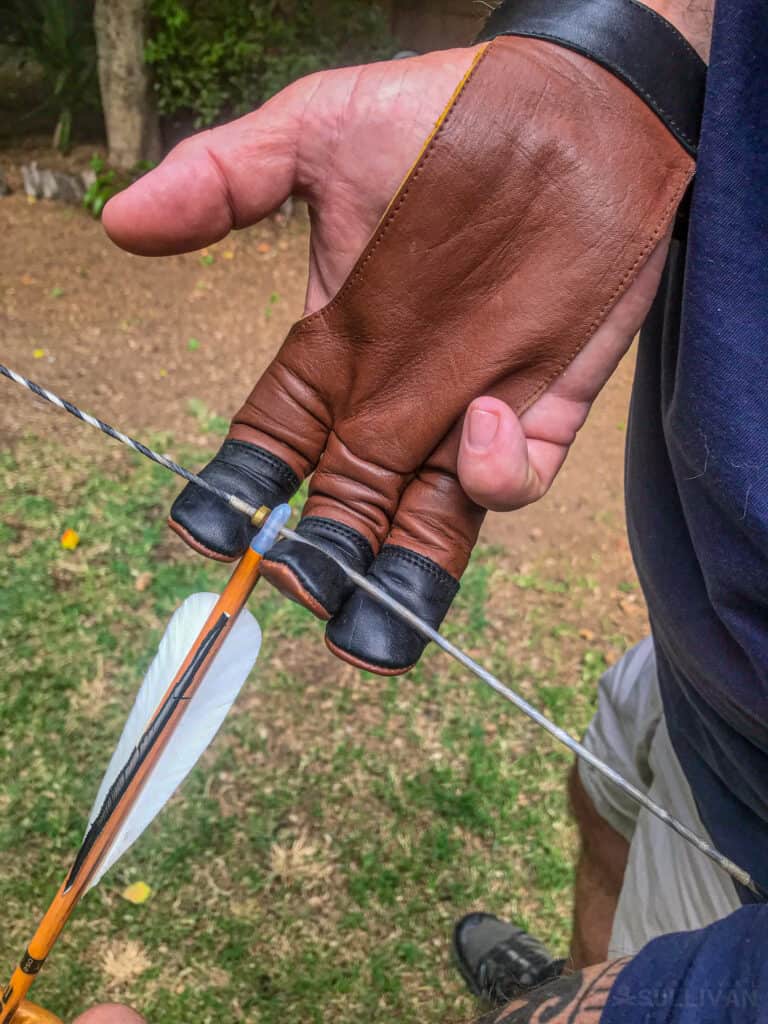
My tab is made from triple leather layers, and seal fur to allow for a smooth release of the bow string. I do however prefer shooting with a bow glove; it offers more versatility as your hand can move freely.
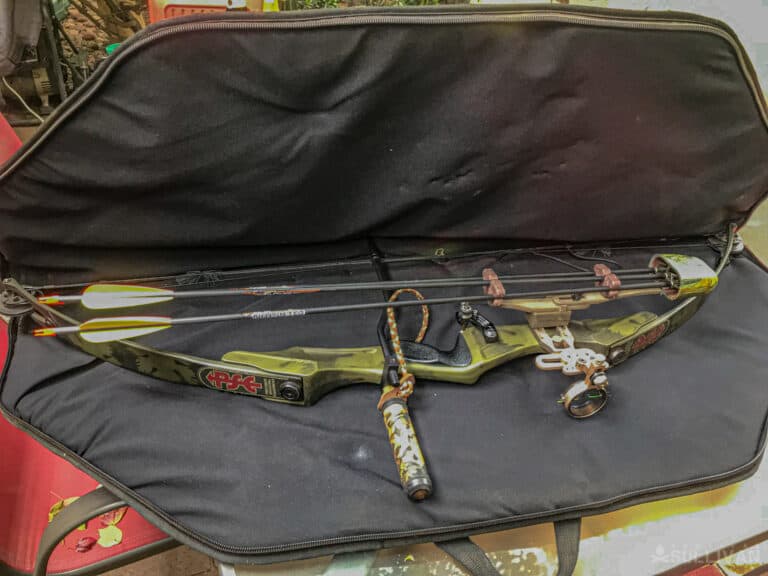
The third is a quiver to hold your arrows whether on the range or in the field.
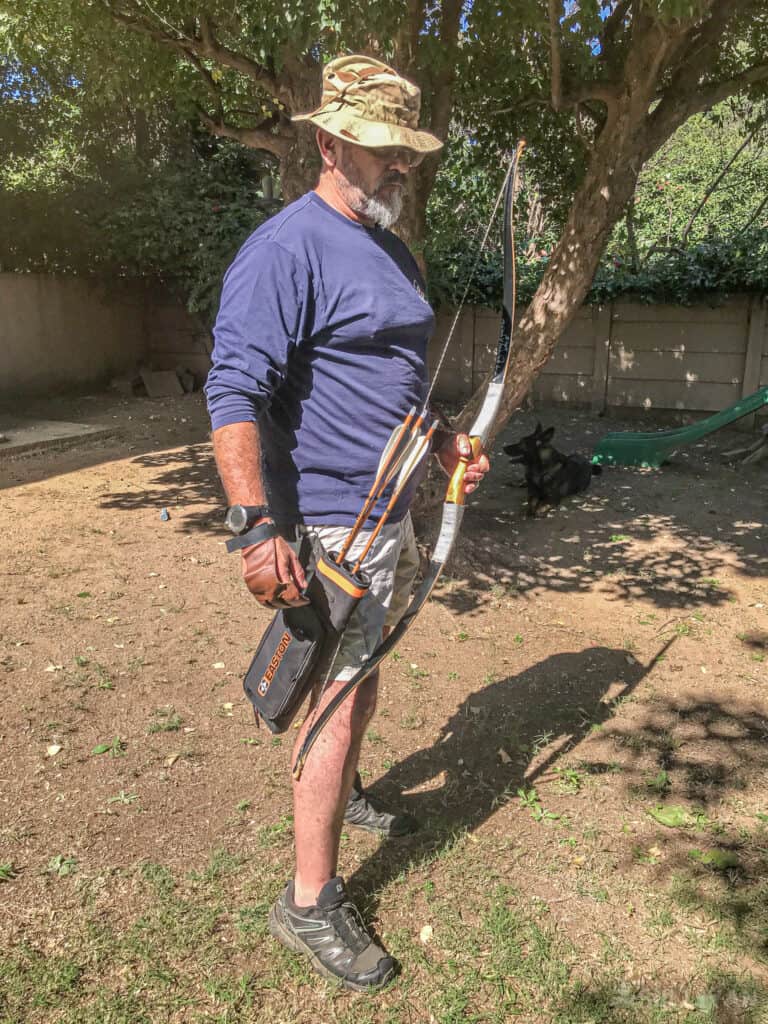
Broadheads especially need special care, they are razor sharp and will inflict serious injury to the archer if not handled and stored safely.
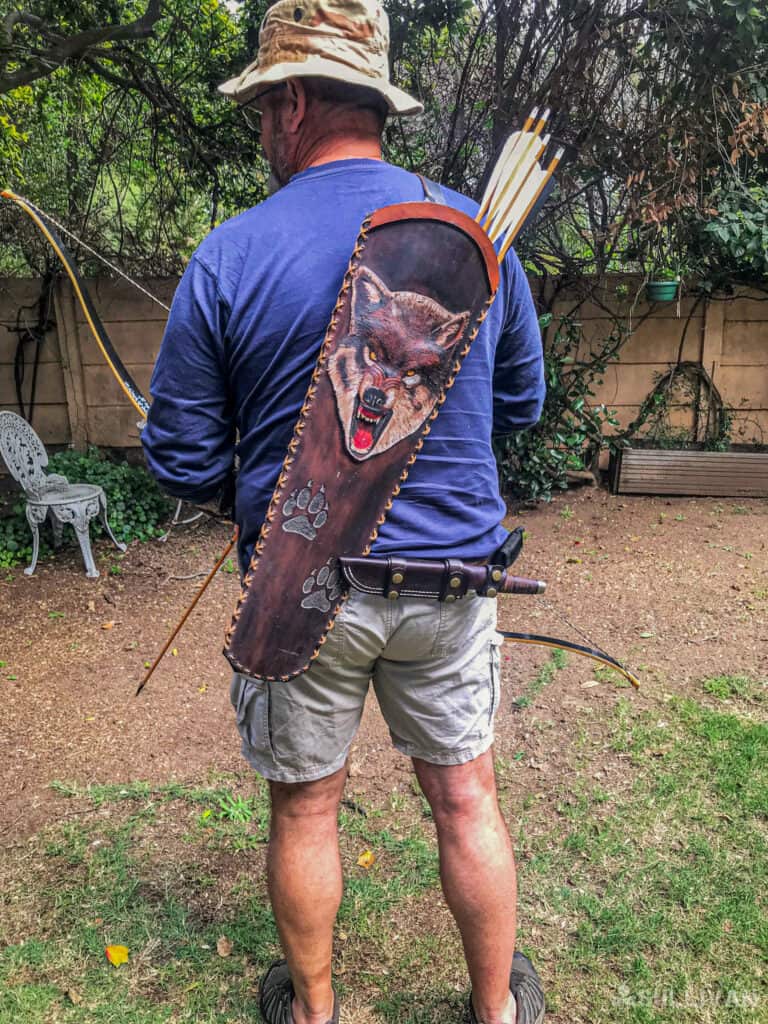
More accessories to consider:
- Back and Leg Quivers
- Bow quivers are one of the most common accessories fitted to both types of bows
- Silencers, help to quieten the “twang” of the bow string on release
- Arrow rests are part of every bow and there are various types
- Sight Systems are varied as they are complex (String Sights, Peep Sights, Fixed Sights)
- Release Systems for recurves are generally a tab or glove while a compound can use these many use a trigger attachment system.
- Bow Fishing Systems consist of attached bow reels, braided fishing lines and fish arrows.
- A Kisser button allows the archer to seat the bow string in exactly the same place for every shot.
Finding the Right Bow for You
Draw Length
Once you’ve decided on the type of bow you want to use, it’s time to look at how to fit the bow to you.
Not all of us are born the same size, and so too with bows. Draw length and draw weight are the most important factors that you should use to determine the bow that is right for you.
Draw length is that point on your cheek where the bow string settles and is most natural for you, from this point to where the stationary bow string is, is your draw length. The bow’s sweet spot is where its peek draw length is.
If you draw under this point you will not maximize the bow’s performance. If you overdraw you immediately add force to the arrow upon release, which can cause the arrow to miss the target.
Use this chart as a rough guide to determining draw length in relation to bow size:
| Draw Length | Bow Length |
|---|---|
| 14 to 16 inches | 48 inches |
| 17 to 20 inches | 54 inches |
| 20 to 22 inches | 58 inches |
| 22 to 24 inches | 62 inches |
| 26 to 28 inches | 66 to 68 inches |
| 28 to 30 inches | 68 to 70 inches |
| 31 inches and over | 70 to 72 inches |
Draw Weight
The draw weight can be confusing, especially in the beginning. How much will do the job? That question is answered by what you want to do with your bow.
A bow requires upper body strength to draw the string back and grip strength to hold it as you take aim.
I recommend finding a range and hiring a few bows of different draw weights and firing at least 15 to 20 arrows out of each bow.
You will gain some experience with each weight and be able to make a more educated decision.
Pro Hint Fire from different positions at your targets, this will place pressure on a variety of muscles that you would not normally use on a conventional range.
Most of your hunting is done in the winter months, so unless you are harvesting game from your own land, the cold plays a part.
Muscles get tired quicker, you burn more calories in the cold, cold muscles don’t always want to cooperate unless trained, and adrenaline surges have a way of throwing out your muscle response when you draw.
Don’t let your ego get in the way when making a purchase; practice first and then make an educated decision. Bigger is not necessarily better for you especially when you are starting out.
Bow Size
Bow size doesn’t always correlate to your physical height, however, there is a general rule of thumb that can be used when making a bow choice decision.
Use this chart as a rough guide:
| Archers Height | Bow Size in Inches |
|---|---|
| Up to 5’6” | 64” |
| 5’6” to 5’10” | 66” |
| 5’10 to 6’2” | 68” |
| 6’2” and Taller | 70” |
Bow Fitness
Start light and build your strength and muscle endurance. As I stated earlier all bows require upper body strength, but the arms, shoulders, chest, and back muscles play the biggest role in strength, while a solid core (i.e. stomach muscles) will keep you balanced.
Firing 20 arrows down range will be similar to doing 20 pushups or 20 bicep curl repetitions, your muscles will burn and lactic acid will flood into the tissue.
The more you practice the more conditioned your body will become, muscles, tendons and ligaments will strengthen and enlarge.
The more you practice the more your body will adapt, it is the human condition to grow under stress.
Your ability to cope, thrive and enjoy the demands of competition and hunting, the weather and the environment will all improve with greater physical conditioning.
You are training for endurance and if you plan to get into hunting or field and 3D target work your aerobic fitness will also need to improve.
Spending hours walking and sometimes crawling through the forests, fields, and undergrowth will take its toll physically.
In a survival scenario, you will need your physical and mental attributes to get you through.
Anyone that has undergone military training will know that good physical conditioning bolsters your mental attitude. You are a winner, but back that up with a stronger body and mind.
Holding Your Bow
You have chosen your bow and are ready to hit the range, Robin Hood is playing in the background and your arrows are itching to find the mark. Let’s take a look at the how of shooting your bow.
These are the basic steps that will get you started. Each body is different, and you will adapt these to your body type with practice, making them your own.
Step 1: Holding Your Bow
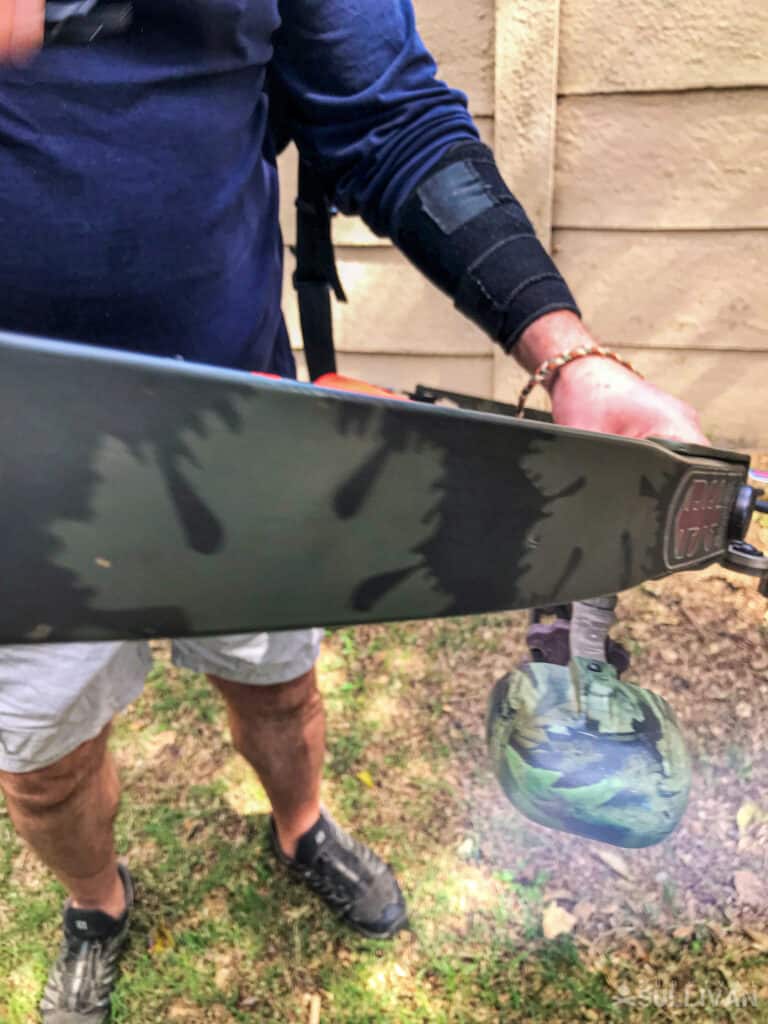
Hold the bow in your left hand if you’re right-hand dominant, and right if your left hand is dominant. This means you will draw the bow string back with your strongest hand.
Step 2: Nocking Your Arrow
Holding the bow parallel to the ground fit an arrow to the bow, pushing the nock over the string, it will “clip” over and remain in place. The arrow will sit on the arrow and rest on the riser just above your hand.
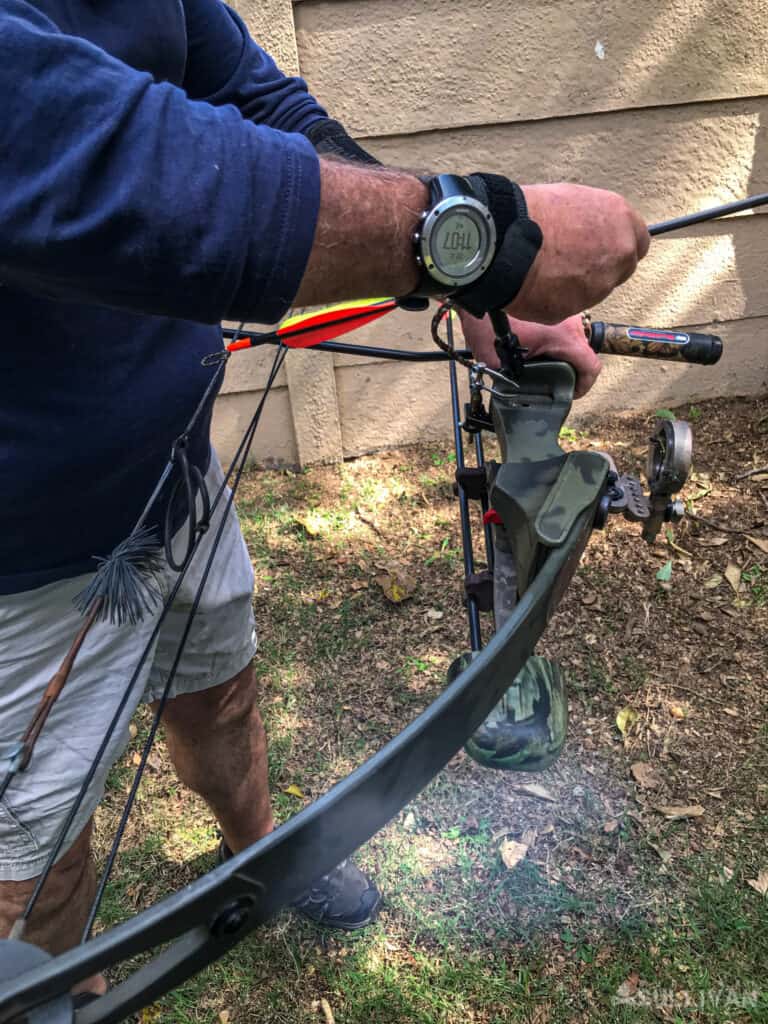
The nocking point on your arrow string will ensure your arrow sits in exactly the same place every time you rig it.
Step 3: Stance
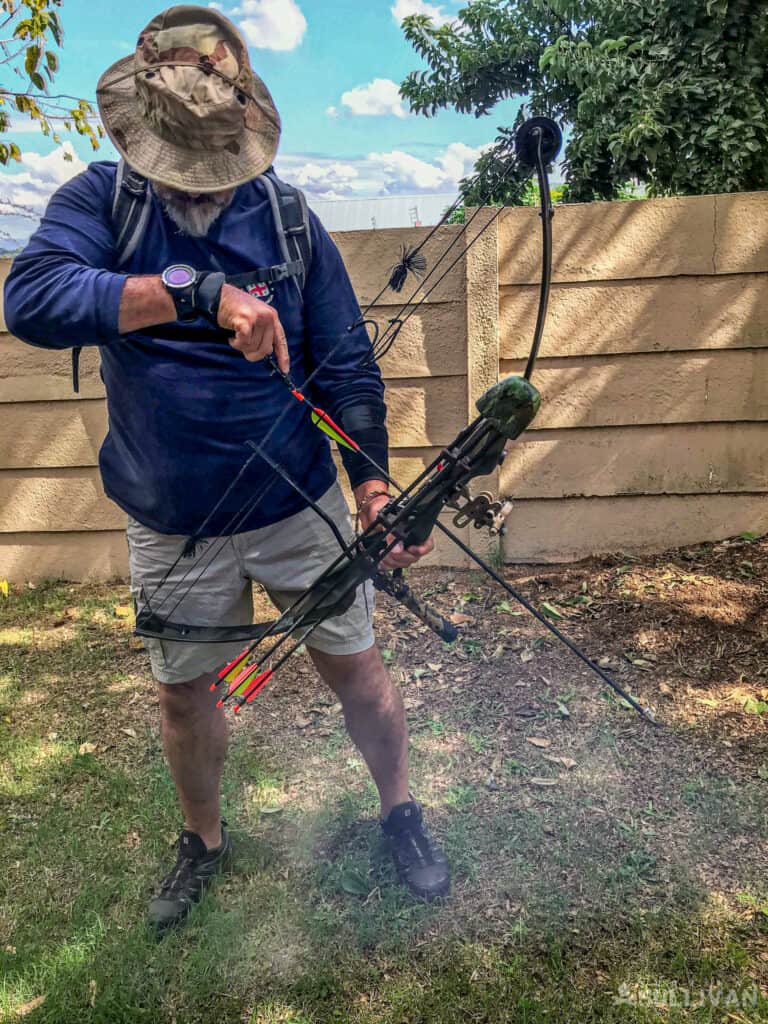
Stance is where to put your feet. If you are right-hand dominant, slide your right foot back, and pivot your body at a right angle to the target.
Your feet will be slightly wider than your shoulders, with your toes facing slightly forward. The heels of your feet must be flat on the ground, not on your toes, comfortable and balanced.
Your left shoulder will be in line with the target, with the bow in your left hand, lift the bow with your index finger pointing at the target. Your left arm is level with your left shoulder.
Step 4: Arrow Rest and Brace
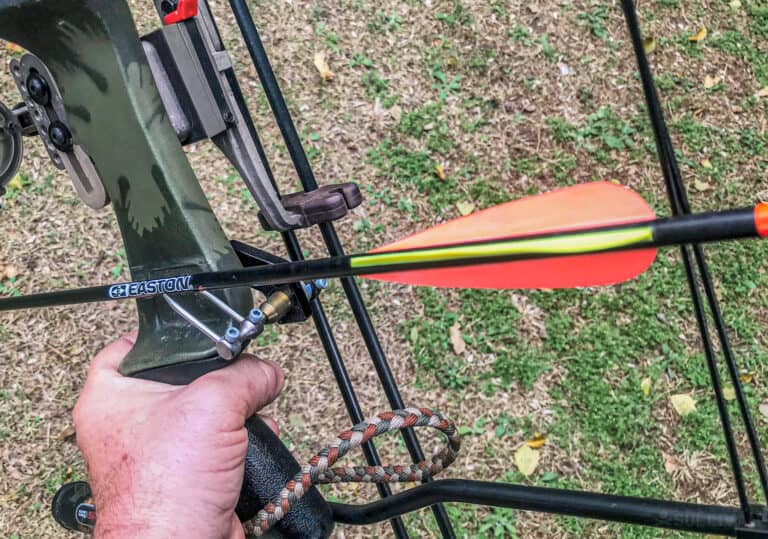
Once the arrow is at rest on the riser and in the arrow nocked, the distance between the string and the deepest part of the bow, the belly is called the brace.
A brace of 6 inches is considered short and will add extra velocity to your arrow as you overdraw to make your draw weight.
This extra velocity is unforgiving of errors in stance, and grip and can cause inaccuracy. As a beginner rather go for but do sacrifice a 7-inch brace or longer brace which is more forgiving.
Step 5: Finger Placement
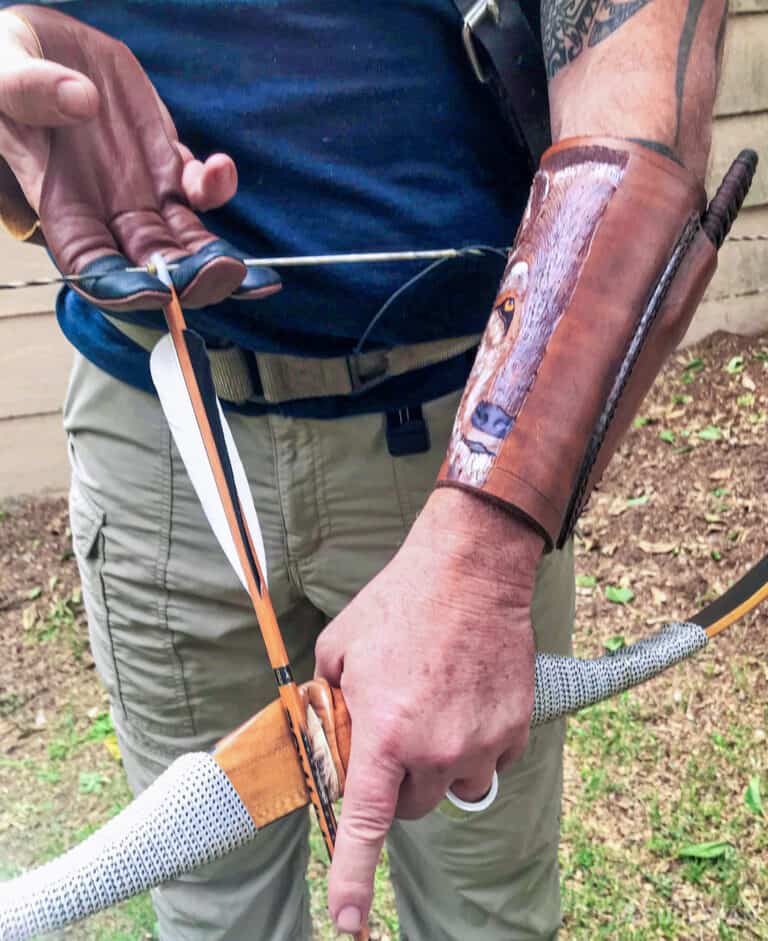
With the arrow nocked, wrap the first digit of the three middle fingers around the bow string.
Place the Index finger above the nock and the other two below the nock, now you are ready to draw your string. This is used more when shooting a recurve bow but is the same for a compound bow.
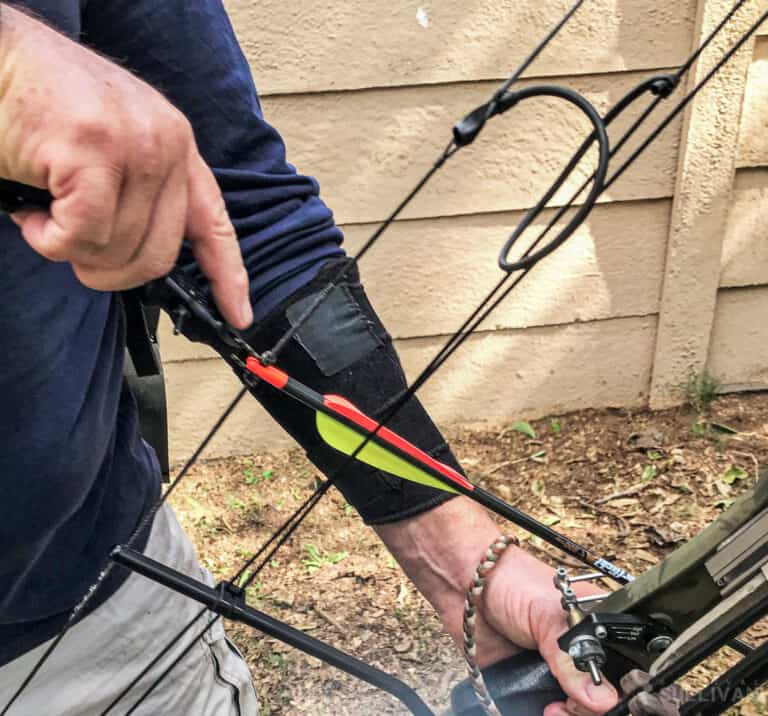
I use a trigger system for my compound bow, the finger placement follows the same rule with the index finger resting above the trigger until ready to release.
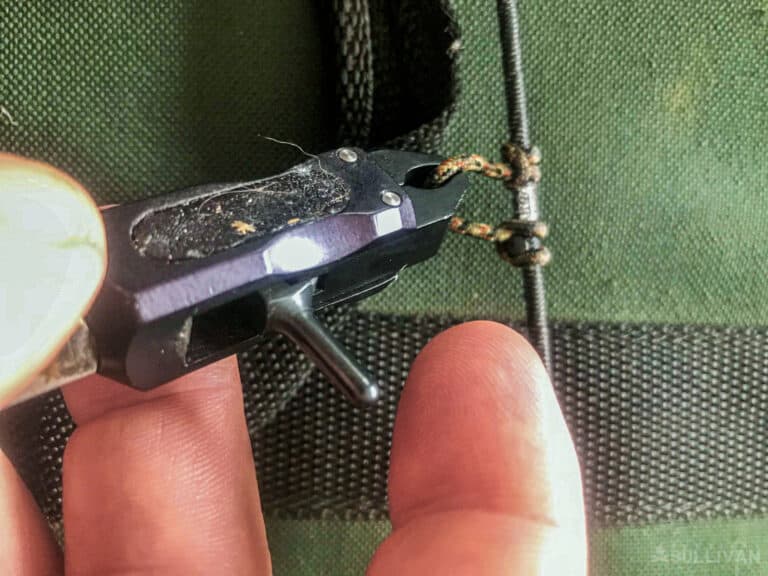
Shooting Your Bow
The Draw
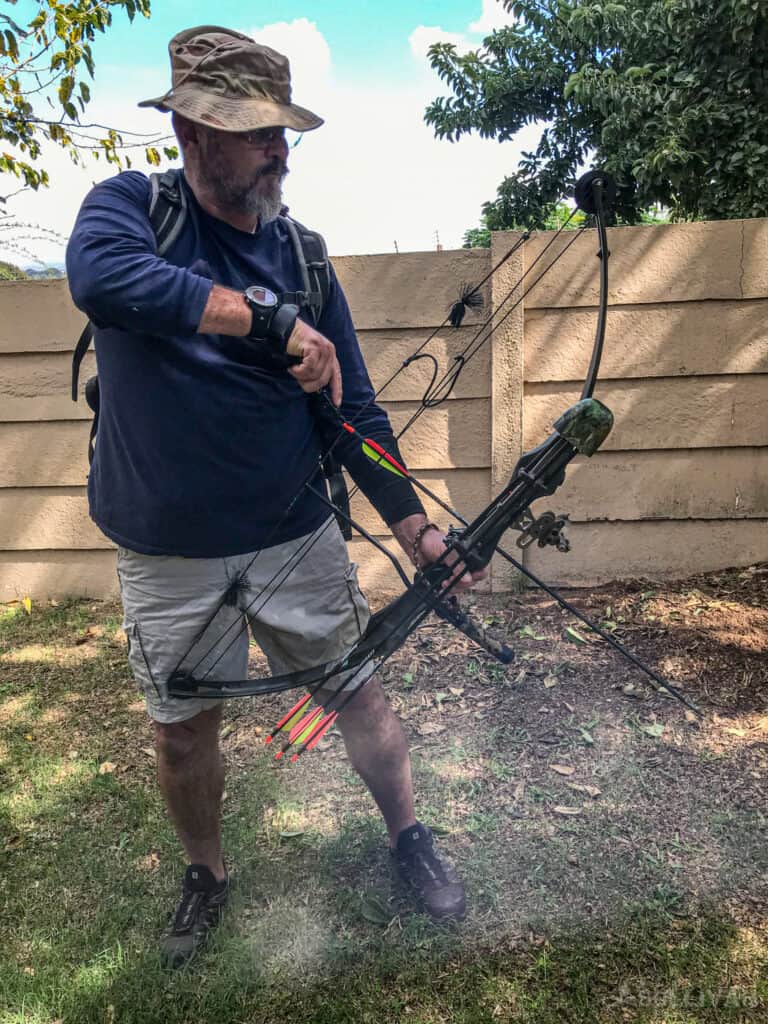
Turn the bow with the nocked arrow to lay parallel to your legs, the arrow pointing safely at the ground. Take a firm grip, but don’t grip it to hard. This is called white-knuckling, or a death grip:
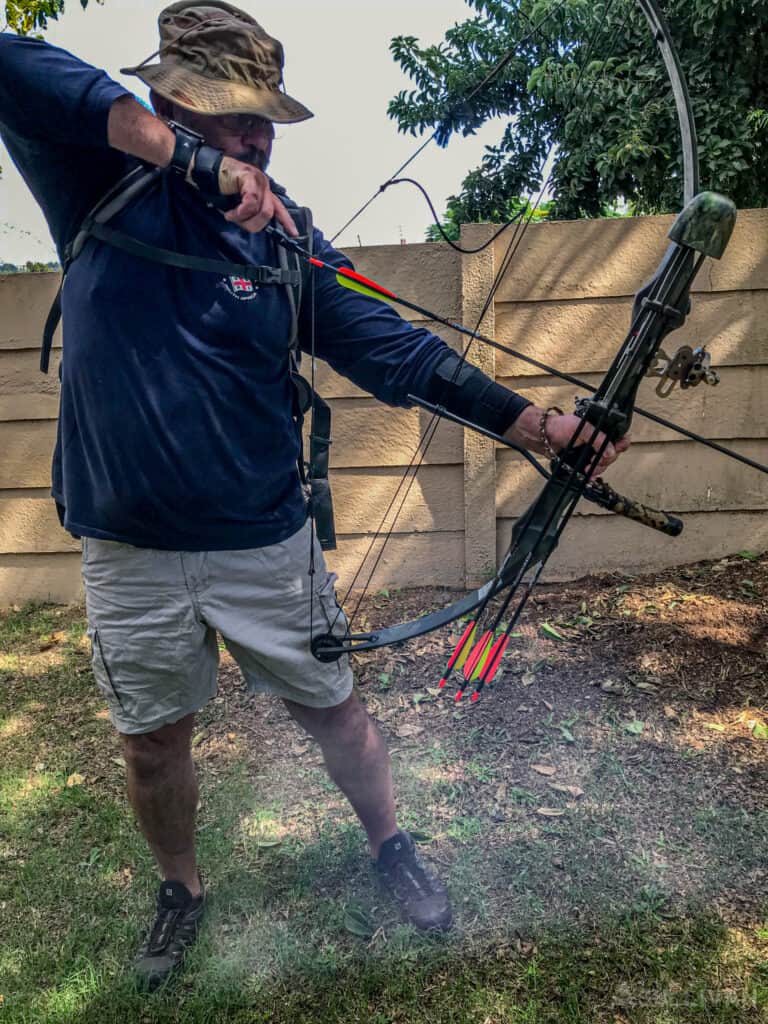
Push your left hand down to the ground, and draw the string back while raising the bow in line with the target.
The bow string needs to settle or anchor on your face in exactly the same spot every time to maintain consistent accuracy:
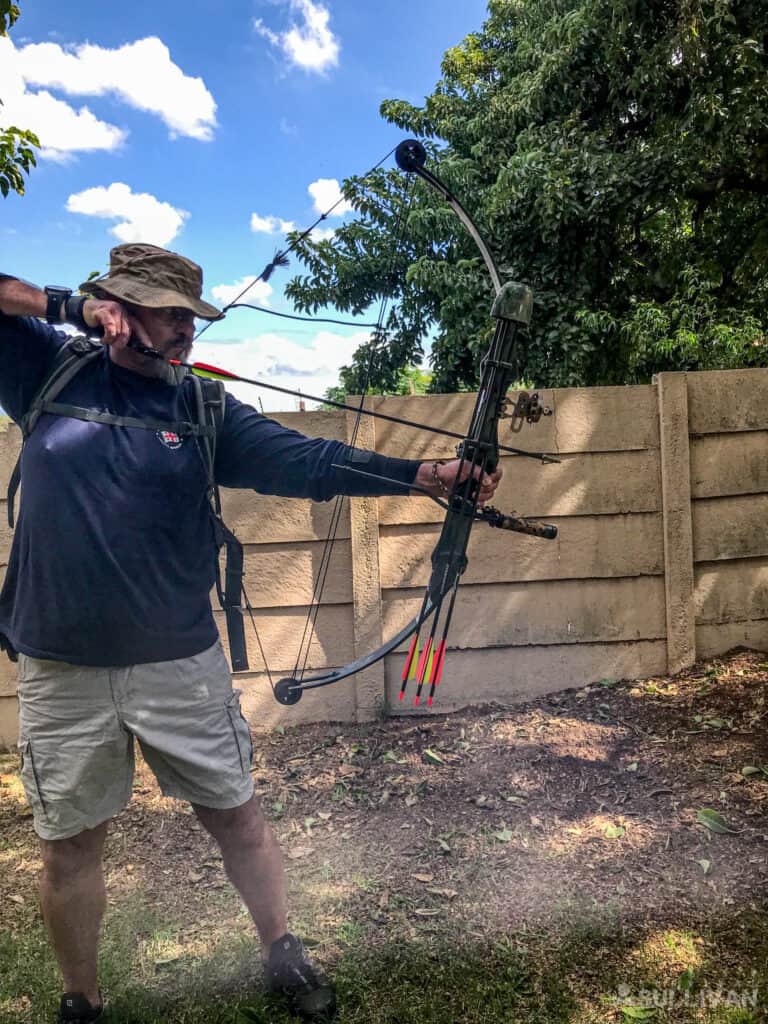
Hold and Aim
Once you have drawn the bow and anchored it, you are holding the string at full draw length for the bow’s maximum draw weight. Now aim down the arrow at your target:
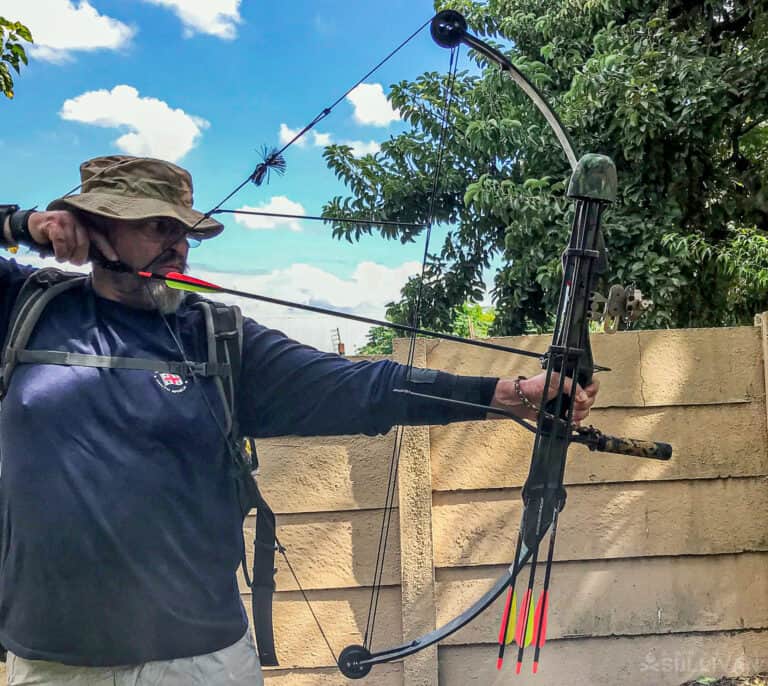
Focus on the target, your body will naturally align to the target. This is called instinctive shooting.
If you’re using bow sights (which are set to predetermined ranges) pick the distance from the target that suits your sight setting and you are ready to lose the arrow.
Try not to hold for too long as you will tire, and your muscles will begin to shake affecting your sight and accuracy.
The Release
The release needs to be automatic and relaxed, once your sight picture is acquired release on an exhale, it’s called the flow, with practice it becomes natural and instinctive.
Follow Through
Don’t close your eyes, it’s a natural reaction so you’ll have to focus on not closing your eyes. Keep looking at your sight picture.
This will stabilize your arrow’s release, your bow won’t move until the arrow has left the bow completely. Any shift in the bow’s position before the arrow has completely left the bow will cause inaccuracy.
In summary, the shooting stance is made up of all the moving parts, your bow, the arrows, the accessories, your body, and your mindset. Practice and practice some more, and most of all have fun.
Once you are familiar with your bow and confident in your skill level, you are ready for the field, so let’s look at the next steps.
Ethical Hunting and Sustainability
Selecting a bow must suit the type of game you intend to hunt. It’s no-good hunting a bison with a 30-pound target bow. The same goes for the arrow type and tip.
Using good judgment in selecting the right tools for the job is also part of being an ethical hunter.
The point of ethics is to ensure that you are skilled in the use of equipment, to ensure your hunt is cleanly. You take the life of your quarry with as little pain and suffering as possible.
Ethical hunting is a natural cycle and is not separate one from the other. Inculcating a deep sense of ethical behavior will bring you closer to being successful.
Good shot placement means you will understand your quarry’s vitals and habits, know when the breeding season is, the foaling down and birds and fish are raising their young.
This is called sustainability, don’t over hunt and there will always be a harvest. This is ethics.
The whole idea is to be part of the cycle of life, understanding the part you play will ensure you make ethical decisions in the field. Decisions that are both legal and morally correct. This is responsibility.
Respecting your environment, the game you target, and your equipment will bring you closer to nature and success. This is called balance.
Bow hunting is legal across the U.S. with each state having its own laws and regulations pertinent to that state. Before heading off into the wilds you must familiarize yourself with the legal requirements for that state.
Nevertheless, you should familiarize yourself with the hunting regulations, state by state, as legal requirements may vary and hunting seasons are not exact.
Never leave a wounded animal, it is up to you to find it and finish it. Sometimes it is impossible, this is understood, as long as you know you have done EVERYTHING in your power as an ethical hunter and a good human being to find your quarry.
Skills and The Environment
Skill levels with bow and environmental immersion (basically your ability to fit in using camouflage, concealment and stealth) will determine your success.
The list of the huntable game is comprehensive, with varying habitats and multiple locations.
Bear in mind that it’s not good enough to know what animals you can hunt and where their vital organs are for decisive shot placement, you need to know their habits.
Where do they sleep, what do they eat, where do they drink water, are they grazers or browsers or both?
When does the grass sprout or the new leaf shoots appear, where do you find the ripe berries, all these are your indicators of where to find and when to find your quarry.
As a hunter you will need a layer cake of skills and knowledge before you even get close, this learning experience will give you a deep appreciation and respect for nature and its inhabitants.
Even the Sun and the Moon affect your hunting experience and the likelihood of success, the most successful hunters in the tribe are those most versed in the environment, they have an intimate knowledge of everything in their environment and how each piece influences the other.
If you know your quarry then you can pick up its spoor and track it. Game paths to and from feeding grounds and drinking holes will help you find your quarry and teach you when they eat when they drink and when they sleep.
Tracking is as old as time, and the basics haven’t changed in millennia. There are different levels of experience that enable the hunter to know the animal is following, how far ahead his quarry is from him, and how long it should take the hunter to draw close enough to take a shot.
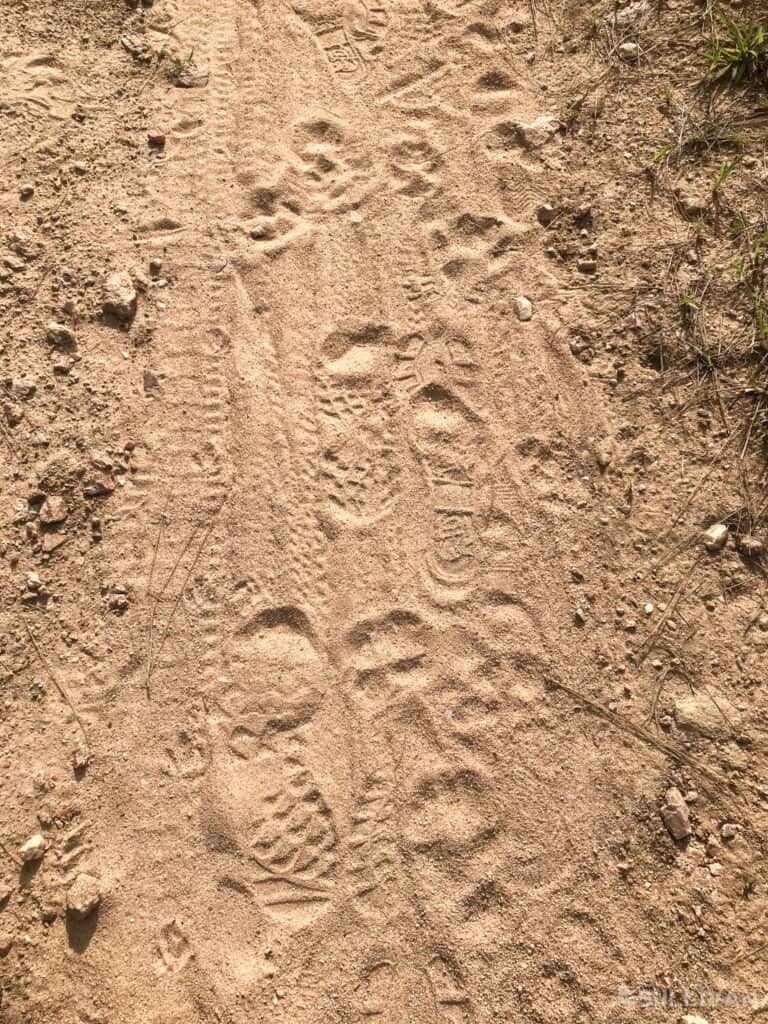
Intimate knowledge of tracking and the environment will help you, the hunter, predict possible changes in animal behavior and direction.
Hunters have to use guile and stealth to outwit their quarry in its backyard. The more time you spend in the field the better you get at anticipating your quarry’s next move.
As a bow hunter your fieldcraft will be far greater than that of a rifle hunter, distance is your biggest challenge as you will have to be better than your quarry to be able to get close enough to be in range.
I could expand on fieldcraft and its multitude of facets for hours but here’s a list of skills and knowledge required when entering the field:
- shot placement
- camouflage and stealth
- tracking ability and environmental knowledge
- species knowledge
- habitat and habits are a broad
I had uncles and family that hunted extensively, growing up on a farm immersed me in the everyday life cycle of domestic and wild animals.
The military provided me with courses that honed my knowledge base, and as a professional hunter in Africa, I was mentored by some of the best bushmen on the continent.
Don’t be overwhelmed, it is a lot of information but help is close at hand. There are hunting organizations in every state and clubs in pretty much every town. Ask at your local bow outlet, and they will guide you in the right direction.
My advice in regards to hunting as a beginner is to ensure you find an experienced group or individual that can aid you on your journey and inform your learning experience.
Scanning and Seeking Your Target
We look at things every day but don’t always see them. Same as hearing.
Look with Seeing, that’s observation. Listen and Hear, that’s observation.
Immersion into your environment will require you to do exactly this. The warning call of a gray grouse, the early evening call of a red pheasant telling would-be suiters this is his turf.
Living in the moment is what it will take to be successful as a hunter. As an added bonus your partner will like the new you, living in the present.
Divide your field of vision into the foreground, closest to you, middle ground, and halfway to the furthest point you can see that is in focus, and the background.
When seeking, start in the foreground and slowly in overlapping steps shift your visual sweep up and out to the background.
Pro tip: Practice this, look through things, look through the bush you are moving in or through, and try to see what is on the other side. This will take conscious practice and will become a habit quickly.
Judging Distance
On the range it is easy to know what the distance is, you can pace out your line to the target or the distances are clearly marked.
In the field things are different, the terrain is uneven and the vegetation can provide an uneven field of vision.
It is important to know the distance to your target, and the only way to be sure is to practice this skill and learn this skill through repetition and varied target placements. 3D Target shooting is an excellent way to develop distance judging skills.
Your everyday doings can be used to practice your skill, think how far you walk from your door to the mailbox then pace out the distance.
Walking from one street corner to another, the distance between trees on the curb or trash cans.
Judging distance is about familiarity and repetition, you get to recognize distances instinctively with continued use.
A simple method, that I use is The Rule of Thumb. Hold up your thumb on a straight arm and cover the object you are looking at, note how much is visible.
The closer you are, the more of the object you will see, and the further away the less. Measure these distances, and start to use your thumb to guesstimate distance. After a while it becomes natural.
Pro Tip: Ask at the club to use the range finder or purchase one, use it to get accurate readings as you practice judging distance.
Game Types
Starting out you are not hunting bears and bison, but a small game. I will stress here that taking a life, any life must be done with the greatest consideration for the animal.
I will be looking at what is termed “edibles,” although everything can be eaten, some game is considered more desirable than others.
Do not kill something you have no intention of utilizing. There may well be life and death situations that impact your immediate survival and fall outside of the utilization ambit. These may well long odds but they are there, so don’t agonize over it.
Default to ethics makes ethical decisions. Resourceful, survival, and sustainable combined with respect for nature and everything in it will make your hunting experience exciting and fulfilling.
Small Game
Squirrels and rabbits are the most common of the small game species hunted. They are common and breed quickly and abundantly.
Harvesting them will be the beginner hunter’s first challenge and easiest learning curve.
Remember to observe your quarry to understand why it does things, what they eat and where they sleep.
Start by sneaking up on them, move slowly, and keep an eye on your quarry, try not to make direct eye contact, there is a direct correlation between your intention and fixating on a target.
Remember that feeling of the hair raising on the back of your neck when someone stares at you? This is the same thing and more so in the animal kingdom when instincts are honed to a fine edge for survival.
Other edibles that fall into this category are porcupines, raccoons, and prairie dogs.
A list of small game will assist you in your learning curve, so be sure to look up which species are more prevalent in your state.
Hunting seasons in general fall outside of the breeding and rearing of young seasons of all animal species, whether it’s hunting or trapping. These regulations are there to ensure sustainability and hunting for tomorrow.
Big Game
Any animal over 40 pounds is considered a big game in the United States. This category consists of deer, bear, and bison, most of which you will not hunt, especially when you are starting out. So, let’s separate them out into what you can reasonably expect to hunt.
In most states (and in general) the bow hunting community agrees that 40 pounds are the minimum for hunting big game, with thicker-skinned animals requiring at least 50 pounds.
These are also broken up into lighter-skinned, medium-skinned, and heavier-skinned game. White tail deer, the most hunted game species in North America, have a lighter skin density than an elk or a moose.
In bow hunting terms this means a heavier arrow being delivered from a bow with bigger draw weight.
Always have your ethics guide your decisions. A wounded animal will put many miles between you and itself and could suffer for days and weeks before blood loss or worse infection finally kills it.
Pick your quarry and stay on track, if you find something else and you are confident of taking it, absolutely harvest that animal.
A comprehensive list of big game will help you choose which big game species are available in your state, and the legal requirements you should follow.
If you are in rough terrain and you have to hump out a large quarry that you have taken, consider that you may have to gut and quarter your animal where you are in order to get back to camp or your vehicle.
A practical guide is best, and lots of practice. Ask your local blockman if they will allow you to help in the processing of their meat supply. There is no substitute for experience.
Birds
Bird hunting is challenging and very rewarding. From doves and pigeons to quail, grouse, and turkey, these will test your fieldcraft and bush skill to the max.
Pheasant and partridges make an outstanding addition to your pantry and are found in almost all states in one form or another.
Water fowl are migratory and frequent water sources throughout the year, remember to stay within the hunting seasons. Here blunt arrowheads are useful as they don’t penetrate the quarry but rather use blunt force to bring down the bird.
Accuracy is paramount when bird hunting, especially birds in flight and this will take a tremendous amount of practice to develop the skill.
Fish
Some states allow year-round bow fishing both inland and coastal. There are species that fall within a prescribed season due to breeding and overfished stocks, this is to allow the fish populations to recover.
The best times for bow fishing and fishing, in general, are late spring through the summer months when carp, pike, and the bottom feeders like catfish move into the shallows of lakes and rivers to spawn. Bass and other predators move in too. Salmon swimming upstream to spawn are also targets.
Invasive species like the Asian carp have no bag limit or season as their removal is seen as a reduction of an invader species.
Refraction is the greatest aiming challenge a bow hunter will face; it is a variation on the sight picture caused by the difference in density between the air and the water. Think of when you place a straight stick into the water, it appears to bend.
Compensate by aiming a little lower than your sight picture, shoot under the center of mass of your sight picture. It takes some practice with underwater targets to figure out, but the rewards are worth your time.
Bow fishing does require bow reels that contain a line attached to a heavier arrow, which allows for the retrieval of the arrow if you miss or the arrow and fish with a direct hit.
Dangerous Game
Things that bite and scratch fall into this category and they are dangerous. Getting stomped by a white tail deer is dangerous or finding the business end of the same deer’s horns.
In this case, I am talking about bears, mountain lions, bison, and musk ox, not to leave out badgers and what has become a scourge, the wild and invasive European and Asian boar.
I don’t exclude feral pigs here, they are dangerous and willy. Their adaptability is obvious and very intelligent.
Bow hunters that are starting out are not advised to attempt to take any of these starting out. Experience is gained 20 seconds after you needed it, remember that.
Gain some experience first, and preferably get involved with the local hunting organization where the collective experience of the seasoned fraternity will guide you on your journey.
The word safari conjures up visions of wild Africa and its diversity of wildlife. Your journey as a bow hunter might encourage you to travel to a far distant land to experience this immersion into another world.
Stay the course and hone your skills. The basics remain the same, the more you practice the better you will get at the basics until they are natural and instinctual.
Most bow hunting is instinctive and you will mostly only have seconds to make decisions, load, aim and take the shot.
Hunting from a Hide or Stealth by Foot Only
Both techniques have a place in the art of hunting. Stealth will cover ambush too, hiding in wait on a well-used game path or an often-frequented feeding area, or using your wits to approach undetected by the ever-vigilant quarry, making your shot at a few feet.
Honestly, both of these have a place in hunting, and when it comes down to survival, all is fair. I for one will not die due to ethics.
That said, there are few instances when you will find yourself in an unplanned survival scenario but if you do then you will at least be prepared.
The overriding decision is, is it ethical to hunt at the only watering hole, when survival is not of paramount concern is not ethical.
There is no challenge. Hunting the paths leading to the waterhole that offer the quarry options is a far better choice, with the greatest challenge being hunting in the quarry open grounds or its hidden places on its terms.
The ultimate challenge would be to hunt with the most basic weapons, but then we are both inventive and imaginative and for that reason alone if none other, humans are the Apex predator in the food chain.
Hunting by Stealth
Camouflage is made up of a number of elements, let’s look at the summary of the main points. When I started my military career the basics of soldiering were drilled into us during the early part of my initial bush phase of training.
The art of disappearing or camouflage is broken up into the seven basics of concealment:
Shape
In nature there are no obvious straight lines or perfectly round shapes, these stand out and are obvious, we even identify land features that have to stand out features.
The same applies to you. When you are moving in the bush, your shape will give you away if you don’t break up the lines of your body shape.
Even solid shapes can be broken up with subtle changes, think of the coat of a deer, it seems solid tan but if you brush the coat back you will see the darker shades beneath. A buck can raise its fur by contracting its skin, exposing the undercoat, and breaking the shape.
Shine
Anything that shines is reflecting light, and that reflection attracts attention. Your face for one, no matter your skin color, will reflect the light, that’s why all camo paint has a matte (non-reflective) finish.
Your kit needs to be treated in the same way. Your orange vest, for example, is visible to other hunters but not to animals because it doesn’t shine and most are color blind so the orange looks brown or gray.
Smell
Just like new cologne attracts attention, any smell that is out of sync with nature will attract immediate attention.
Soap, shampoo, nail varnish, and shoe polish that have a high sent content, can all give up your position without your quarry ever seeing you.
Very strong body odor can also be a giveaway, the rule is to try to remain as neutral as possible, so it doesn’t mean skipping on personal hygiene, it means being aware that your toothpaste may need to be organic or brush your teeth with bicarbonate of soda the morning of your hunt.
I have heard of hunters spraying themselves with animal urine or applying animal dung to their bodies or clothing, just make sure it’s not a skunk.
Old Hunter’s Tip: Stay Down Wind – trickle some dusty sand through your fingers, watch in which direction the loose dust blows, and stay downwind of the prevailing wind.
Shadow
Your shadow is sometimes not your friend; you can think you are perfectly hidden with the sun catching you and casting your shadow giving away your position.
Remember shape, your silhouette will show up in perfect lines if the sun catches you at the right angle, stay off ridge lines during the day or on bright nights.
Sound
Sound is an obvious one. We, as a species, like to talk, even when alone. Be aware that you are in your quarry’s back yard and they know everyone in the neighborhood and what they sound like.
If you are singing, whistling, or chatting, every living thing within earshot will be moving in the opposite direction as fast as they can. Work out hand signals with your partner to keep the chatter down.
Spacing
Anything that forms a regular pattern like a fence line or your backpack’s outline or your temporary camp or your hide.
Movement
Movement is a giveaway in itself and will be covered shortly, it is discussed here because of the snapping twig, the grinding gravel underfoot, the tree branch that has rattled when you braced yourself against it, these are the tells you give away.
Hunting From a Hide
Hides are a means of concealment where the hunter will wait for the quarry to come within range to take the shot.
Hides can be made of natural vegetation with a shooting port, ideally, it will have a 180° view of the possible approach.
Tree stands are hides that are built on a tree platform above the ground, giving the hunter the high ground over a game path or a regular feeding area.
Hides come in either man-made or self-made enclosures or platforms. There are a number of retailers that will supply prebuilt, easy to erect hides.
Moving in the Field
The single most telling give-away sign anywhere is movement. Quick movements, running, and sharp turns, all get people’s attention and so it is in the field. The movement will give away your position in a New York second.
Moving By Day
Watch where you put your feet, especially if you are moving up on your quarry. You can’t tiptoe through the bush all day, you’ll never get very far.
However, once you have spotted your quarry or are moving into an area where your quarry is likely to be found, then stealthy movement is paramount.
Keep to covered areas, and try to stay within the shadows, moving within the cover is part of concealment, stealth is moving quietly, combining the two aspects of camouflage will help you disappear.
I mentioned silhouette earlier in relation to breaking the outline of a ridgeline. This also applies to open water, if you break the “cover” to collect water, you need to create the smallest possible shape.
Walking upright to the edge of the shore is natural, and you will have a large profile silhouetted against the background.
If you have to cross through long grass, stay as low as possible and move carefully, if there is a breeze, utilize the grass movement to conceal your move through the grass, the movement will otherwise attract attention.
If you disturb small birds or wildlife, sit still and wait for things to settle, many times this disturbance can work in your favor, some animals are curious and will move closer.
Moving By Night
The darkness conceals everything, you will need to know your environment well, as a movement by night is dangerous. The same rules for daytime movement apply especially silhouette and cover.
In a survival context, you may have no choice and can take advantage of animals at rest in order to harvest.
Stay in the shadows, but remember deeper shadows or darker shadows are also revealing especially they are shaped.
Basic Hunting Gear Necessities
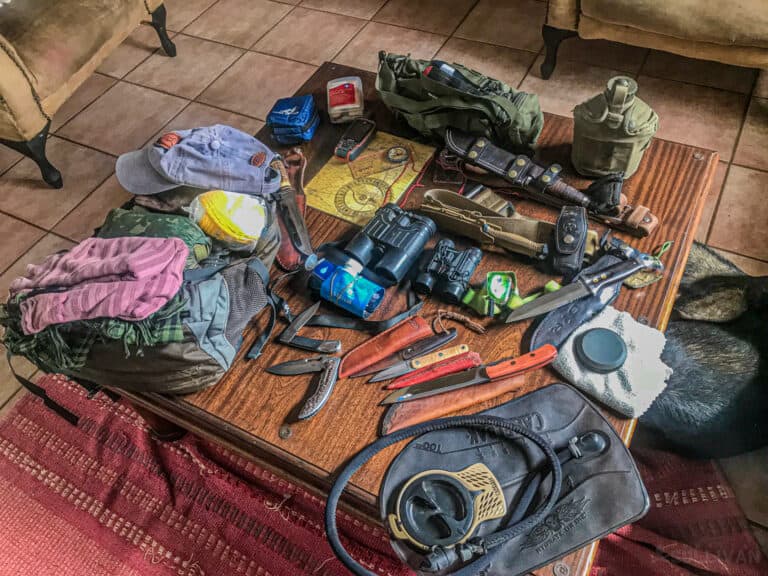
Footwear
I don’t have a particular brand to recommend, but rather the most comfortable boots that you can afford. Just like a good knife, fit and finish must override looks.
Don’t go with flash, I repeat your boots must fit your feet like a glove. You will walk far in them and they will bear your weight and all your kit.
I do recommend boots at a minimum ankle length and waterproof. Leather is age-old and well-proven; it is easy to clean and maintain. Modern materials provide many benefits too, so it’s a matter of personal preference.
Pro Tip: The boots you try on must fit across your foot and the length of your foot. Boots really stretch to fit the shape of your foot, don’t swallow that marketing hype. Have your foot professionally measured if you can?
Small Backpack
Always have a small day pack at a minimum, and a bigger pack with a frame for longer trips or if you are hunting a bigger quarry.
Carry a small medical pack, two days’ rations, a poncho that can be converted into a bivi or hide extra clothing layers, and if you can, a change of clothes. Also a compass and map of the area you are going to move in, a VHF radio if possible, and a GPS if your budget allows.
Water
If possible, get a day pack that can accommodate a water bladder, 2 or 3 liters would be great. If no bladder, water bottles at least 2 liters unless the water is readily available.
Water purification tablets and/or portable water filters. I personally use a Sawyer system; it has seen action in many different environments and worked perfectly.
Knife
Knives are a personal choice and vary from hunter to hunter. What I will recommend is a versatile pocket knife and a 4-to-6-inch drop point fixed blade at a minimum. I would add a multitool, there is a number of really good makes on the market, I personally use a Leatherman.
Binoculars
A good set of lightweight binoculars is a necessity. Being able to spot your quarry at a distance will help you plan your approach.
Survey the terrain and use all available cover to get you within shooting range, remember your bow has a limited effective accurate range.
Practice, Practice, Practice
An archery club will provide you with the support you need as you start your journey, not only will you be able to get the advice you need, you will have access to equipment.
As other archers move up in experience or change direction on their archery journey so their equipment comes up for sale.
Most clubs have access to farmers’ lands, and are connected to the US and Wildlife Service, they can assist with hunting permits, access to private hunting areas and club conservancies.
If you have the space, you can set up your own shooting lane at home, 15 meters to 25 meters will give you solid hunting distances to practice on.
Regular practice is vital in maintaining your shooting edge and regular exposure to the hunting grounds will keep your fieldcraft sharp. It is part of being an ethical hunter and a good hunter.
Fitness and muscle condition are degradable and waste away if not maintained. It goes to your safety first and your ability to be ready to make the perfect shot when it presents itself. No good gassing when you are a few meters from your prize.
Key Takeaways
Bow hunting in my opinion is the pinnacle of hunting. It tests your equipment, your physical and mental attitude, and your ability, combining these attributes with your fieldcraft experience to culminate in the most challenging experience you can enjoy as a hunter.
Maintain your skill level, this is a daily, weekly, and monthly exercise.
- Find a range near you, your local retailer will help guide you here
- Practice with as many bow types as possible
- Chose a bow that suits you and what you intend to use it for
- More practice with your bow
- Hone your fieldcraft
- Study animal behavior
- Familiarize yourself with your environment
- Ensure you remain legal in your state
- Be ethical
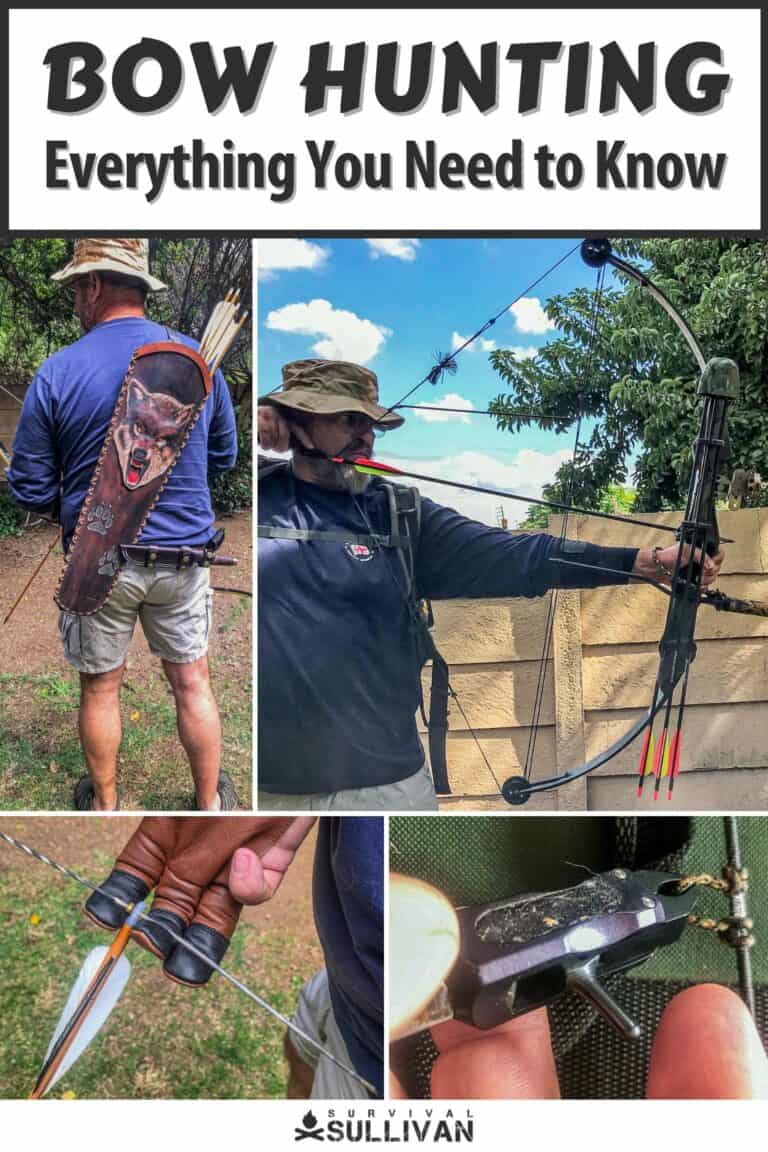

Harrison Caine is a soldier, a hunter, a trained expert in hand-to-hand combat, hunting. He’s trained soldiers, fought wars, and provided defense services to refugees and U.S. officials. His experience in tough wilderness scenarios is unmatched
